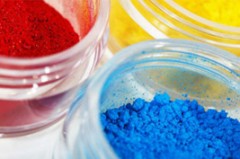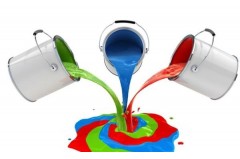Application
18 Knowledge Points Of Powder Coatings
Powder coatings are solid powdered synthetic resin coatings consisting of solid resins, pigments, fillers, and additives, etc. It exists in the state of fine powder and is called powder coating because no solvent is used.
This blog lists 18 knowledge points about powder coatings, which are highly relevant to the production of powder coatings. You will understand the actual production of powder coatings through these simple and easy-to-understand interpretations from a production perspective.
1. Orange Peel
It refers to the irregular surface structure of the powder coating that looks like the skin of an orange.

2. Impact Resistance
In some end-use applications, powder coatings need to suffer sudden impacts. Impact resistance refers to the ability of the powder coating to resist impact.
The impact resistance relates to the type of substrate, its thickness, its treatment methods and the thickness of the powder coating. Impact resistance is also considered to be the indicator to determine whether the powder coating is sufficiently solidified.
3. Vitrification Temperature
There are three common states of material existence in nature which are solid, liquid, and gas. The glassy state is a special state of material between solid and liquid, just like molten glass which is neither solid nor liquid.
The vitrification temperature is the critical temperature at which the polymer is converted from the highly elastic state (which can be called the rubbery state or solid state) to the glass state or the temperature at which the latter is converted to the former. This temperature is commonly expressed as TG, and it is an important physical index of polymer including powder coatings.
4. Flash Point
When heating powder coatings to a certain temperature, its vapor mixes with the surrounding air contact with the flame, triggering a flash ignition. The minimum temperature at which flash ignition occurs is the flash point.
5. Slope Liquidity
Slope liquidity refers to the flow characteristics of a molten thermosetting powder coating on the slope that has a fixed tilting angle.
6. Melting Range
Melting range refers to the temperature interval from the powder coating starting to melt to completely melt. The upper and lower limits are called the initial melting temperature and the final melting temperature. The initial melting temperature is the temperature at which the powder coating begins to melt, and the final melting temperature is the temperature at which it melts completely.

7. Rest Angle
The rest angle of a particle is also known as the repose angle or stacking angle. It is the angle between the vertebral busbar and the horizontal plane when the particles fall continuously through a small hole onto the horizontal plate. The rest angle relates to dust type, particle size, shape and water content. The smaller the particle size, the larger the rest angle; the smoother the particle surface or the closer to spherical particles, the smaller the rest angle; the greater the moisture content of dust, the larger the angle. Rest angle is one of the dynamic properties of dust.
8. Cross-linking Density
It refers to the number of cross-linked bonds in a cross-linked polymer and is generally expressed by the size of the molecular weight of the net chain. The greater the cross-link density, the more cross-linked bonds per unit volume. Thus the degree of cross-linking is greater and the compactness of coating film will be better.
9. Gelling Time
It is time to heat a thermosetting powder coating and reach the crosslinking and curing temperature. It can also be understood as the time required for the continuous thickening or caking process of the material. The shorter the gelling time, the more active the material.
At sufficient temperature and time, thermosets will undergo a chemical reaction of curing and cross-linking to produce a net structure. Temperature increase or reaction time prolong will increase the cross-link density. When the density increase to a certain extent, the material will suddenly become non-fusible, and can no longer be pulled into a filament so the material is internally gelatinized
10. Edge Coverage
It is the ratio of the thickness of the edge coating (90 degrees without chamfering) to the flat surface of the coated test bar under the condition of specified plane coating thickness.
11. Coating Porosity
It is the number of pinholes and defects on the coating.
12. Epoxy Equivalent and Epoxy Value
Epoxy equivalent is the amount of resin containing one epoxy group (g/equivalent), i.e. the average molecular weight of epoxy resin divided by the number of epoxy groups contained in each molecule. Epoxy value is the number of epoxy group equivalents per 100 grams of epoxy resin, and the unit is equivalent/100g. The relationship between epoxy value and epoxy equivalent – epoxy value=100/epoxy equivalent.
13. Corner Coverage
It refers to the ability of the powder coating to flow, construct, and adhere to sharp corners in a corrosive environment.
14. Surface Profile
It refers to any irregular or corrugated appearance profile of the powder coating, a special requirement for powder coatings. The surface profile of the powder coating is mainly determined by the nature of the powder coating itself, but some other factors will also affect the surface profile, such as the substrate, film thickness, drying conditions, application environment, etc.
15. Acid Value of Polyester
The acid value indicates the free acid contained in organic substances such as grease, polyester, and paraffin. Specifically, it refers to the mg value required to neutralize 1g potassium hydroxide under test conditions. The polyester acid value is divided into high, medium and low values. Different acid value determines different kinds of curing agent and amounts added.
16. Coverage
Powder coating must be opaque to cover the color of the substrate. Coverage refers to the minimum amount of powder coatings used to be evenly applied on the object’s surface so that the base color is no longer present. Its unit is g/m2. The strength of coating coverage is mainly determined by the following properties:
- Refractive index. The greater the refractive index, the stronger the coverage.
- Light absorption.The greater the light absorption capacity, the stronger the coverage.
- Crystallinity. Crystalline forms have stronger coverage, amorphous forms have weaker coverage.
- Dispersion.The greater the dispersion, the stronger the coverage.
17. Particle size distribution (D*)
This is a common parameter in the particle distribution. “D” represents the accumulation, and the number after represents the particle size (um) when accumulated to *%. For example, D90 represents a particle size (um), and the sum from the smallest particle accumulated to that size is 90% of the overall amount of particles.
The D10, D50, and D90 give an approximate picture of the particle size distribution. The larger the difference between these three parameters, the wider the particle size distribution, i.e. the larger the difference in particle size. In general, D50 is basically close to the average value of the particle size. The particle size distribution can be represented by number distribution, surface area distribution and volume distribution. And in each of these distributions, there will be D10/D50/D90.
18. L, A and B Values in Colorimeter
Color difference refers to the numerical method to express the difference between two colors to people’s color perception, usually called the E value. E value = the open square of [(L standard – L measurement)2 + (A standard – A measurement)2 + (B standard – B measurement)2].
LAB color scale is marked as follows:
- L axis (luminance) indicates black and white, with 0 being black and 100 being white.
- A axis (red-green) positive value for red, negative value for green, 0 for neutral.
- B axis (yellow-blue) positive value for yellow, negative value for blue, 0 for neutral.

As environmental awareness takes root, the market is paying more and more attention to the pollution problems that exist in traditional coatings, and the advantages of zero waste and zero pollution of powder coatings are gradually coming to the fore. Wu Xiangping, secretary of the Painting Branch of the Chinese Chemical Industry & Engineering Society, said that China’s powder coating production and sales volume accounted for about 60% of the world, and China is leading the development of powder coating and decoration. It is foreseeable that in the future, powder coatings will usher in a broader market and rapid development opportunities.
Precipitated Barium Sulphate is one of the most common powder coating fillers, with the advantages of high whiteness and fine particle size.




